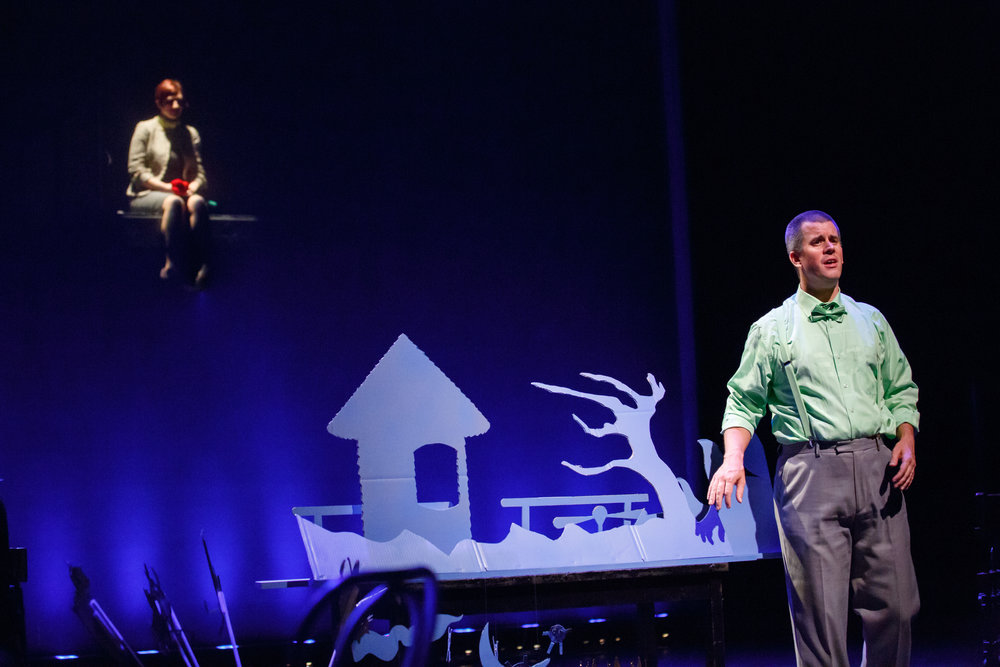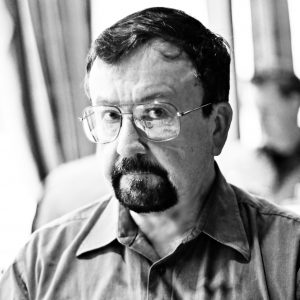by Dave Zuchowski, ‘Burgh Vivant.
The Pittsburgh New Music Ensemble has been a mainstay of the Pittsburgh music scene for many years. Now ready to begin its 43rd year on July 6 with a 4-week series, the Ensemble will perform at the City Theatre on Pittsburgh’s South Side.
The first two weeks alone will feature five world premiere commissions, a not unusual occurrence considering the Ensemble’s legacy of performing more than 300 world premieres. Interestingly, the season spotlights topics as varied as “the tragedy of infertility to the need for remembrance, from the five stages of grief to a genre bending tribute to Bernstein, Gillespie, and Monk, and all the way to the goofy but poignant remarks of children around the dinner table.”
The series of concerts will include not only music but also visual art, poetry, shadow puppetry, and animation – and Week 4 will reprise “The Gray Cat and the Flounder,” which enjoyed two performances during PNME’s 40th season to a packed house in 2015 and a closing night SELL OUT performance – the first in the Ensemble’s history.
Below artistic director, Kevin Noe discusses the upcoming performances with Burgh Vivant’s Dave Zuchowski. A detailed account of the upcoming season can be found on Dave’s blog www.pittsburghowlscribe.blogspot.com

DZ: Does the Ensemble have a regular corps of musicians that are augmented by soloists when needed? If so how many are regulars and how to you go about selecting them and the appropriate accompanists for each work? Are they mostly local talent or do they come from much further away?
KN: The PNME Theatre of Music is made up of a core ensemble flute, clarinet, percussion, piano, violin, cello, soprano, bass-baritone, lighting designer, and sound designer. This is what we consider to be the “lime green dream team”. There are three members of the ensemble that have been with me for 17 of my 18 years, and most have been together for 10+ years. Every once in a while, we have a team member move on, but it takes us years to replace them! The type of intense work that we do in working with brand new compositions incorporating staging, lighting, theatrical elements etc… the important thing is trust! We all trust each other implicitly and it’s the only way we are able to create the art we do in the timespan that we have. When we commission works, composers know of our instrumentation, but sometimes can’t help themselves but to write also for a double bass or a trumpet for example. We have only a few (if any) guests per year that perform with us. It all depends on the season.
The only one of the team who live here in Pittsburgh is Andy Ostrowski, our lighting designer. Everyone else is spread throughout the country and the world. Our pianist was born in Sweden but lives in Vienna, our violinist was born in London but lives in Paris. The rest of the team is spread all around the country throughout the rest of the year and we all convene just once a year in Pittsburgh and bring the best of all worlds together for our audience.
DZ: The program for Week 1 lists three world premieres by American Composers Forum national competition winners chosen from 474 applicants. Each one has a specific theme with a broad range of inspirational fodder. The selected compositions vary in thematic content from dinnertime conversations between the composer and his 2 and 4 year old sons to a touching tribute to the 100th birthdays of Thelonius Monk, Dizzy Gillespie and Leonard Bernstein (three artists who have influenced jazz bassist and composer to Rufus Reid’s work) and Elizabeth Kübler-Ross’s classic model of the Five Stages of Grief – Denial, Anger, Bargaining, Depression and Acceptance – woven into words and music by composer, Jung Yoon Wie. How did these three particular pieces end up on your program and will the aural experience be as wide ranging and sundry as their thematic referents?
KN: These three compositions are commissions – and incredible ones at that! The competition was set up so that we chose three composers to write us a piece for PNME. Last summer they came to Pittsburgh with us during July and saw the vibe, met the musicians, experienced the type of art that is possible in our Theatre of Music and then left to composer during this last year having a real understanding of the possibilities for their composition to be premiered this weekend! Thematically the three compositions may seem very disjunct on paper but wait until you see how we pull all the threads together this weekend. It is really going to be a strong concert – one of our strongest all-commission concerts ever in our history. Throughout the organizations 43 years we have commissioned over 300 new works, not all of them successful, but this weekend we lucked out. These three composers created stunning pieces and we’re so honored to be working with them this week. Shout out to the incredible American Composers Forum for making this concert possible.
DZ: Several of this month’s series of concerts involve a collaboration between the Ensemble and visual artists, puppeteers, poets even a cartoonist. Has the Ensemble had an extensive history of working with artists outside of the musical arena? How are they and their work woven into the upcoming performances and how do they affect the overall audience experience?
KN: Yes! We call ourselves the PNME Theatre of Music because truly anything goes! We pride ourselves on using music for the vehicle for larger ideas, but if the story is best told through dance or slam poetry as well, we will make it happen. Our audience is incredible. They all show up not knowing what to expect, but having real trust that the experience, no matter what is it, or how it is realized, will be worth being there for.
DZ: I see that you’ve been credited with developing a presentation style for the Ensemble now known as “Theatre of Music.” Could you explain what is meant by this term?
KN: When I came to PNME in 2000, there was a lot of great commissioning happening, but it was all concert style, and to me, lacked guided listening. The audience in 2000 was the typical new music audience – composers, musicians, etc, and was not accessible to a broader group of listeners. Once I started truly focusing on the audience, a lot of things started to take shape for me. We started to incorporate lighting and sound design as fundamental tools for expression. We also put storytelling, no matter the media, at the forefront. Our audience is mainly made up of NONmusicians now, and I couldn’t be prouder that they trust us to bring meaningful experiences to them year after year even if they have no base for understanding how.
DZ: Any advice for newcomers who may not be familiar with New Music? How should they approach the concerts, what should they expect and what do you hope they will take with them when they leave the theater?
KN: A Theatre of Music concert isn’t a typical New Music concert. Yes, commissioning new work is a big part of our mission, but audience members come having no expectations because they have learned over the years that one weekend’s concerts at PNME are completely different than the next and the following. One may lend to Music Theatre, the next hard core New Music, the next jazzy with poets or dancers etc. You never know what you’re going to get at PNME. As for walking into any New Music concert, even if it’s not something that is necessarily your favorite composition… it is still great to always keep in mind that the page was blank, and the composer sat down and decided what you are hearing is what they wanted to express. The page was BLANK! I am so grateful to have worked with so many truly extraordinary composers and it has given my life so much meaning.
DZ: What drew you to New Music and, as someone who is also immersed in theater, opera, writing, stage directing and playing the trumpet, how much time do you devote to it? How do you balance all these different areas of interest in your life?
KN: I’m not sure I’m necessarily drawn to new music – per se. I am drawn to deep artistic experiences shared with an audience. The artistic media itself isn’t actually that important to me, but the connection to the audience means everything. Working in New Music means working on creating new work – of our time – for our generation – born of today. It also means getting to work with some of the most talented musicians I’ll ever have the honor of working with as many of the finest musicians in the world today focus on new music and early music.
I devote as much time to it as I possibly can, but certainly it is never enough. Since my life and career have always been divided into two parts as a dedicated teacher who believes passionately in working with younger people, and as a professional performer/creator who is focused on creating new experiences for audiences, I’ve continually juggled those two identities. Perhaps at some stage I’ll wind up focused on just one, but I will always have a heart in both camps.
DZ: As an avid advocate of the arts, what do you see as the value of art for either a creator or consumer and for individuals as well as society at large?
KN: When art is impactful it positions us to better understand our world and our unique place within it. Art gives form, identity, and perspective. It gives us time and place. This broadened and color filled awareness gives art its power. Even during the most divisive period we’ve been in during my lifetime, we are all more similar than we are different. Art of all mediums has a way of bridging the gap between us and reminding us what being human is all about. This is why I go. I need that. And on the nights that it really hits – there’s nothing better. I leave knowing my world is always bigger than I could have ever imagined.
For tickets and more information on Pittsburgh New Music Ensemble’s 2018 Season, visit www.pnme.org.



